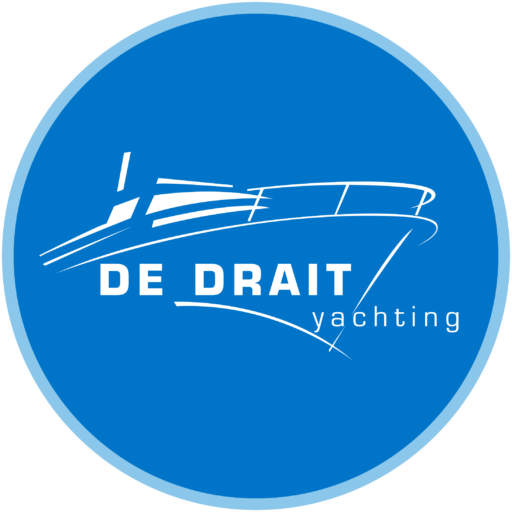Victoria
Kotterjacht 1220 GL
Dimensions + technical data
Length: 13,00 meters
Width: 4,00 meters
Draft: 1,10 meters
Clearance height: 3,90 – 5,30 meters
Water tank: 1000 litres
Waste water tank: 400 litres
Fuel tank: 400 litres
Steering position Victoria
Steering position
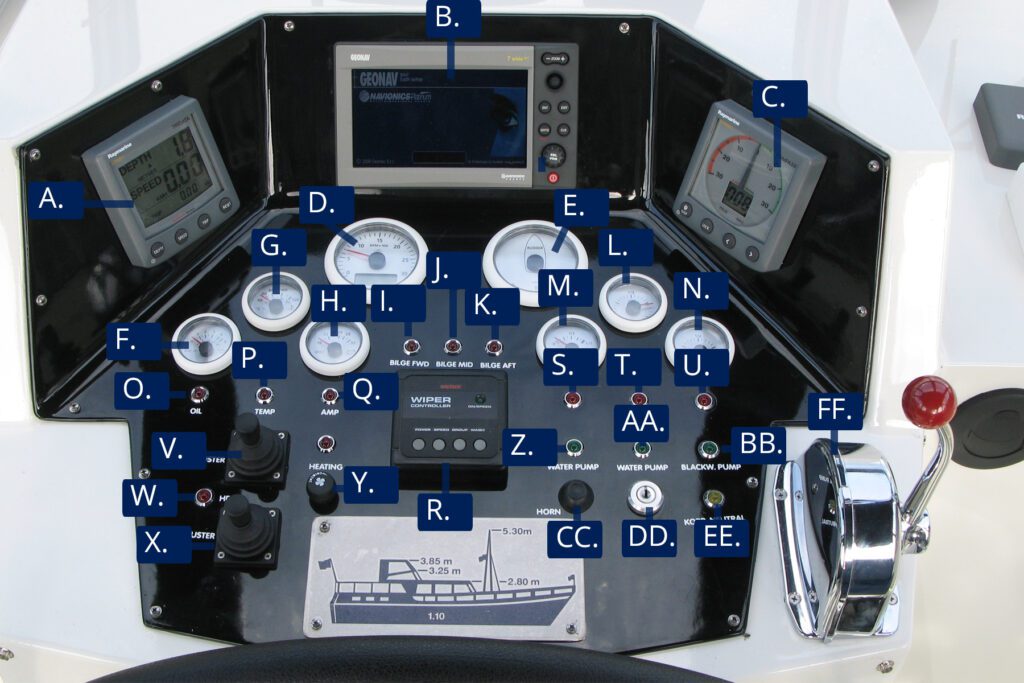
A. LOG / Depth meter
B. GPS with chart plotter
C. Compass
D. Tachometer
E. Rudder position
F. Oil pressure
G. Temperature meter
H. Battery voltage
I. Indicator light bilge alarm front
J. Indicator ligth bilge alarm middle
K. Indicator light bilge alarm back
L. Water meter
M. Fuel meter
N. Waste water tank
O. Indicator light oil pressure alarm
P. Indicator ligth temperature alarm
Q. Indicator light ampère
R. Windshield wiper
S. Indicator light fuel tank empty
T. Indicator ligth water tank empty
U. Indicator ligth waste water tank full
V. Bow thruster
W. Level hydraulic oil
X. Stern thruster
Y. Heating steering position
Z. Indicator light drink water pump 1
AA. Indicator light drink water pump 2
BB. Indicator ligth waste water pump
CC. Horn
DD. Ignition lock
EE. Indicator ligth throttle neutral
FF. Throttle
Control panel (inside)
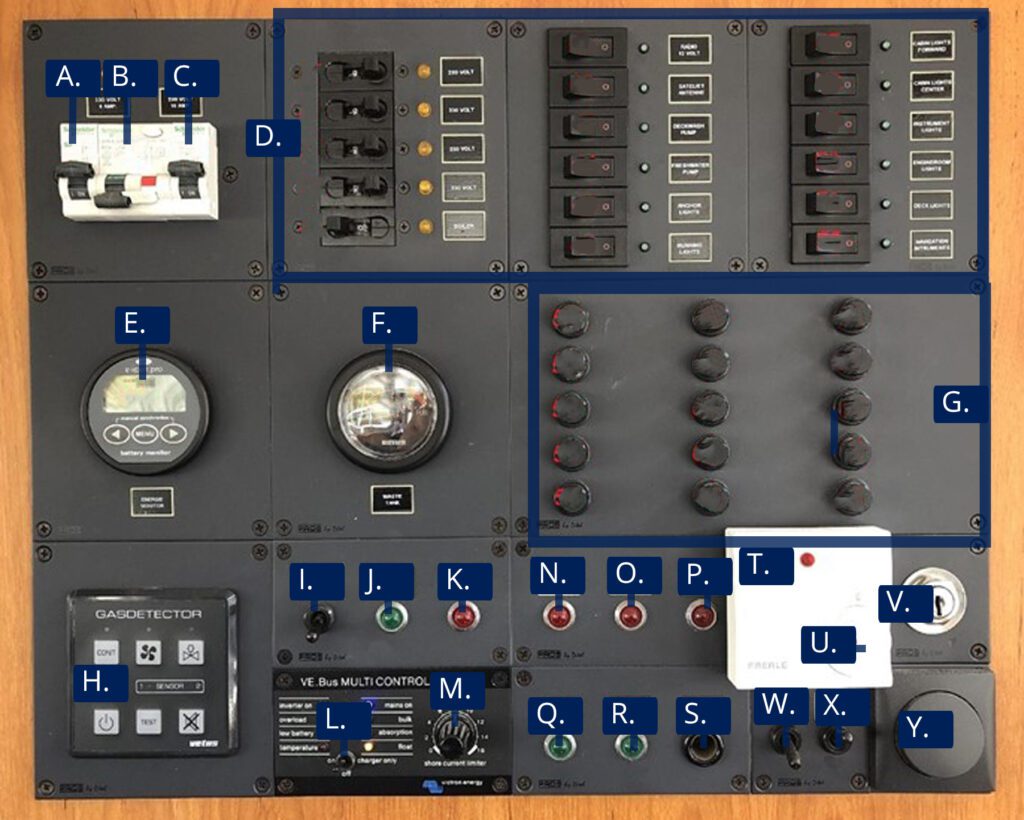
A. Automatic inverter 8 Amp.
B. Earth leakage circuit breaker on-board network 220 Volt
C. Automatic at shower power 16 Amp.
D. Switches (check below)
E. Battery monitor
F. Waste water tank meter
G. Fuses (check below)
H. Gas detector
I. Switch waste water pump
J. Indicator light waste water pump in use
K. Indicator light waste water tank full
L. Inverter / Battery charger
M. Current control battery charger
N. Bilge alarm front
O. Bilge alarm middle
P. Bilge alarm back
Q. Indicator light water pump 1 in use
R. Indicator light water pump 2 in use
S. 12 Volt connection
T. Thermostat + switch on central heating system
U. Set up temperature
V. Ignition lock
W. Switch speaker steering position
X. Switch lights ceiling salon
Y. Light dimmer salon and back
Switches (control panel inside)
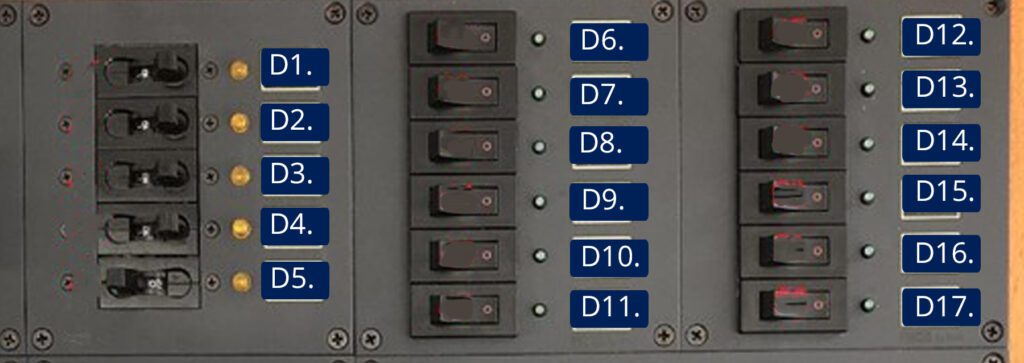
D1. Automatic fuse 220 Volt
D2. Automatic fuse 220 Volt
D3. Automatic fuse 220 Volt
D4. Automatic fuse 220 Volt
D5. Boiler elektrically heated via shore power
D6. 12 Volt / Radio
D7. Satellite antenna and Tuner
D8. Deck wash pump
D9. Drink water pumps
D10. Anchor light
D11. Navigation lights
D12. Main switch lights
D13. Main switch lights
D14. Instrument lights
D15. Engine room lights
D16. Deck lights
D17. Navigation instruments: LOG, kompass, depth meter and GPS
Fuses (control panel inside)
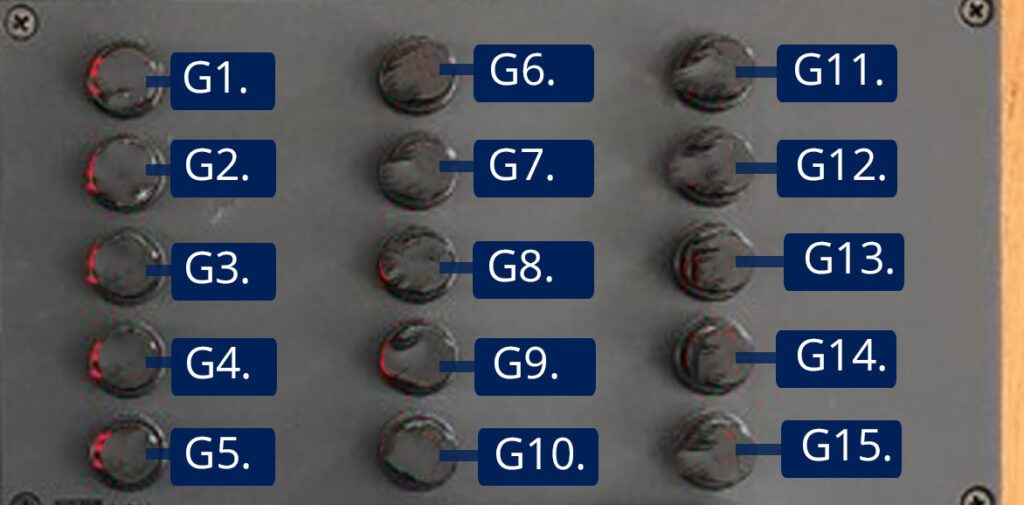
G1. Fuse for toilet pump back 15 Amp.
G2. Fuse for toilet pump front 15 Amp.
G3. Fuse for refrigerator kitchen 10 Amp.
G4. Fuse for refrigerator salon 10 Amp.
G5. Fuse for radio and GPS chart plotter 10 Amp.
G6. Fuse for bilge pump automic front and middle 10 Amp.
G7. Fuse for bilge alarm front, middle and back / gas detector 5 Amp.
G8. Fuse for waste water pump and tank measuring 20 Amp.
G9. Fuse for power supply control current
G10. Fuse main current heater 25 Amp.
G11. Fuse ignition lock / instruments 10 Amp.
G12. Fuse fan and circulation pump stearing position heater 10 Amp.
G13. Fuse engine alarm and horn 15 Amp.
G14. Fuse for windshield wiper 15 Amp.
G15. Fuse for hydraulic control 10 Amp.
Main switches (under the stairs)
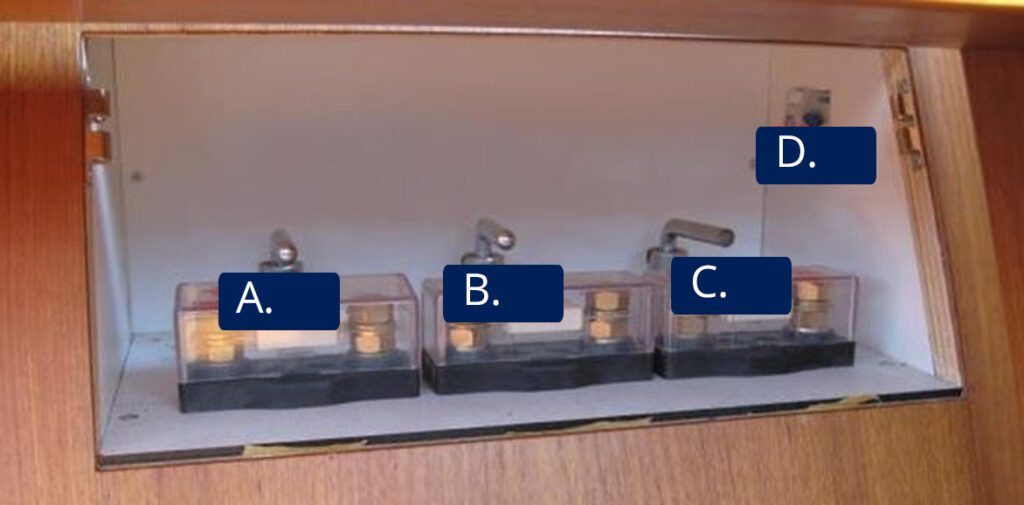
A. Main fuse/ switch battery charger inverter
B. Main fuse/ switch for lighting
C. Main fuse/ switch for starting group
D. Earth leakage circuit breaker boiler/ shore power
Grease pump propeller shaft
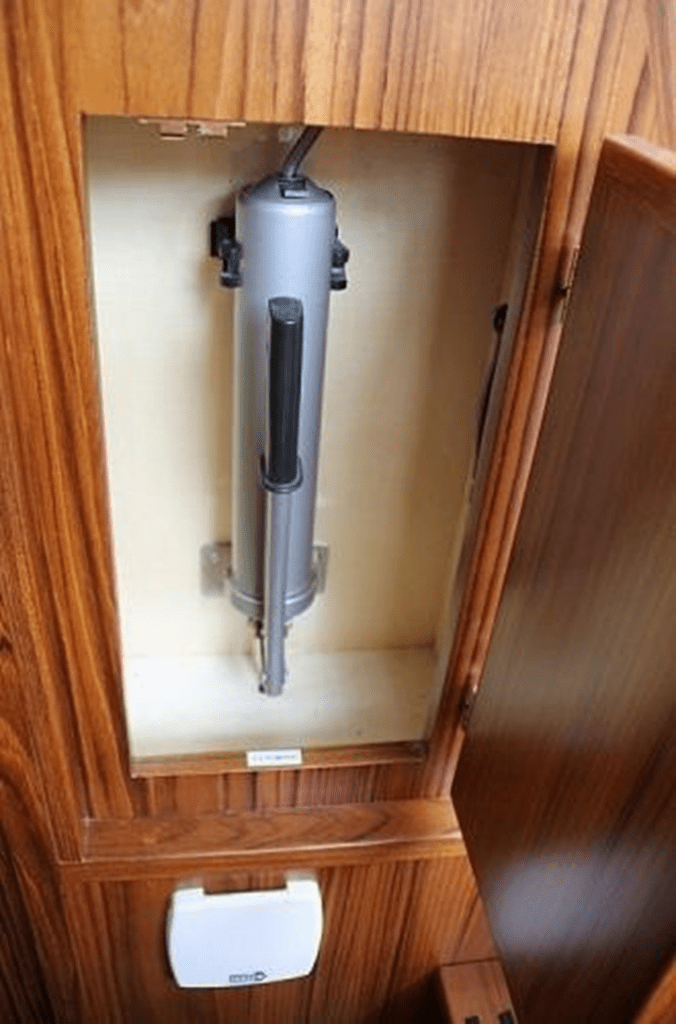
With this grease pump, you should lubricate the propeller shaft each day before departure. Pump three times each time.
Start and stop the engine
Starting the engine
Make sure the throttle lever is in neutral. Insert the small round key into the control panel in the saloon and turn it to the right, so that power is supplied to the instruments and the ignition switch. Then insert the ignition key into the ignition lock at the steering position and turn the key until the engine starts.
Throttle lever
Neutral: middle position
Forward: push forward
Reverse: pull backward
Tip: Pause briefly (1–2 seconds) when shifting between forward, neutral and reverse.
Stopping the engine
Turn the key in the ignition lock back until the engine stops. Make sure to remove the key or turn off the ignition. If the boat remains on ignition, a loud alarm will sound after approx. 30 seconds. This is the oil and temperature alarm. At that moment, the oil pressure is too low or the cooling water temperature is too high. Quickly turn the key back or remove it from the ignition.
Bow and stern thruster
This boat is equipped with a hydraulic bow and stern thruster. This means the thrusters are not connected to a battery that can run out. The hydraulic system only operates when the engine is running. You do not have to separately turn on the bow and stern thruster. Which means they are active as soon as you start the engine. Use the bow or stern thruster only for maneuvering.
Using the hydraulic bow and stern thruster
When you move the bow thruster joystick to the left, the front of the ship moves to the left. When you move the bow thruster joystick to the right, the front of the ship moves to the right. The same applies to the stern thruster, but for the rear of the ship. Use the bow or stern thruster for about 3 seconds (maximum 5 seconds at a time!). Then observe how the boat responds. If necessary, use it again for 3 seconds. Continue this process until the desired position is reached. Do NOT use the bow and stern thruster simultaneously. This will result in a loss of power, causing it to take longer to reach the desired position. Alternate between the two thrusters for the best result.
What to do if the bow or stern thruster doesn’t work?
If the bow or stern thruster is not working on this boat, please contact us via +31 512 513 276.
Power supply
The boat has multiple batteries:
-A battery for starting the engine (starter battery);
-A battery for the bow and stern thrusters (except in the case of hydraulic thrusters);
-A battery pack for onboard power (house batteries).
While cruising, the batteries are slowly recharged. However, charging is much faster when the boat is connected to shore power. Therefore, if the battery voltage is low, we recommend finding a berth with a shore power connection.
It is generally possible to spend one night without a shore power connection, but we advise connecting the boat to shore power the following night.
In the salon, you’ll find a control panel for the inverter (Victron Energy, see photo). Make sure the inverter is always set to ‘on’. There is also a rotary knob to adjust the number of Amps. This is usually set between 8 and 12 Amps by default. It’s important that the Amp setting is equal to or lower than the number of Amps available at the shore power connection.
For example, if a marina provides 12 Amps at the power pedestal, you can set the knob to 12. If the knob is set higher than the available shore power, the fuse may trip. In that case, reduce the Amp setting and reset the fuse.
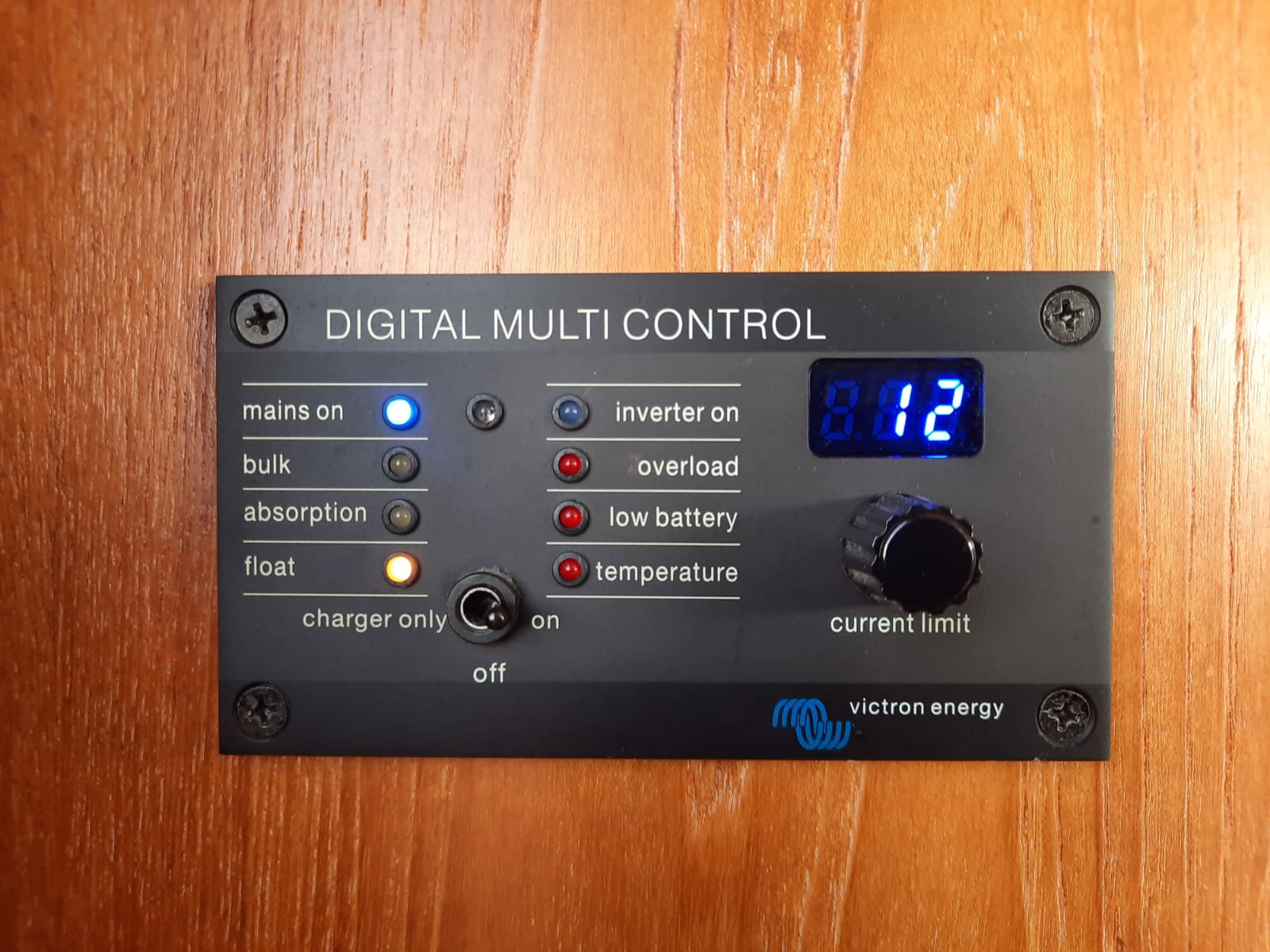
What to do if there is no power on board?
Check the power supply on board at the fuse box (located in the salon). Check the indicator lights for 230V via the inverter and 230V via shore power. Also check if any fuses in the fuse box have tripped. No indicator light? Check if the power outlets are working and whether the fridge is still running. If these also have no power, the battery voltage is likely too low, and you should first connect the boat to shore power so the batteries can recharge.
If the boat is connected to shore power, check if it is actually charging. Some boats are equipped with a battery monitor in the salon, which can be used to check whether the batteries are being charged. You can also verify this on the inverter panel or by checking the indicator lights in the fuse box. Not sure if the batteries are being charged? Try plugging the shore power cable into a different outlet. If in doubt, ask the harbor master to check whether the power pedestal is supplying electricity.
- Check the inverter control panel in the salon:
Skyla control – Victron Energy:
–Charger on = Shore power is connected and the batteries are charging.
–Boost charging = Battery voltage is low, charging at full power.
–Float charging = Batteries are charged, being maintained/trickle charging.
Digital Multi Control – Victron Energy:
–Mains on = Shore power is connected and batteries are charging.
–Bulk = Battery voltage is low, batteries charging at full power.
–Absorption = Battery voltage is higher (80–90%), still charging.
–Float = Batteries are charged and being maintained/trickle charging.
–Inverter on = Inverter is active because shore power is not connected.
–Overload = Batteries are overloaded due to high power consumption.
–Low battery = Batteries are deeply discharged; this light stays on if shore power is not connected properly.
–Temperature= Batteries are getting hot; often lights up along with overload. - If there are no lights on the inverter panel, check the inverter switch in the fuse box. Is it off? Switch it on. Is it already on? Switch it off, wait one minute, then switch it back on. This will reset the inverter.
- If none of the above helps, please contact us at +31 512 513 276.
Heating
The central heating (CV) on this boat runs on diesel. In addition, sufficient electrical power is required for the system to function properly. There is a thermostat in the salon, which you can use to set the desired temperature. Make sure the radiator valves in the cabins are open so they can also heat up.
Important: Always check that no fenders are hanging in front of the heater exhaust before turning the heater on.
This boat is equipped with an Eberspächer heater, which controls the central heating on board. Hot water is supplied via the boiler. The boiler only works when the boat is connected to shore power or when the engine is running.
What to do if the heater doesn’t work?
Check the battery charge level on the battery monitor at the control panel in the saloon. If the percentage is below 60%, the batteries may be too deeply discharged to provide enough power for the heater to function. Connect the boat to shore power so the batteries can recharge. Try again once the batteries are sufficiently charged. Still not working? Please contact us at +31 512 513 276.
What to do if there is no hot water on board?
Check if the boiler switch on the control panel in the saloon is turned on. Also check whether the boat is properly connected to shore power and if the batteries are charging (verify this on the battery monitor at the control panel in the saloon or on the inverter panel). If both answers are ‘yes’ and you still have no hot water, please contact us at +31 512 513 276.
Toilet
The boat is equipped with an electric toilet. Normal use of toilet paper (maximum 2-ply) is not a problem. However, always flush well to prevent it from getting stuck in the pipes. Do not throw wet wipes, sanitary pads, and/or tampons into the toilet! This can cause blockages.
How does the toilet work?
The toilet has two buttons that look like light switches. One button is for adding water to the toilet bowl. The other button is for flushing (pumping out) the contents. Always flush properly to ensure everything is cleared. Make sure a small layer of clean water remains in the bowl after use to prevent unpleasant odours.
What to do if the toilet does not work?
If the water doesn’t flush away, the toilet is likely clogged. Wait approx. 12 hours before using the toilet again to allow the blockage to soften. Then press the flush button again. If the toilet still does not work, please contact us at +31 512 513 276. If the blockage is caused by incorrect use of the toilet, charges may apply.
TV + radio
The boat is equipped with a TV with satellite reception. Please note: the satellite is set to a German satellite. This means that only German channels are available on this TV.
How does the TV work?
1. Turn on the satellite by switching on the satellite switch on the control panel in the saloon.
2. Then activate the automatic satellite dish using the control box on the ceiling in the saloon. Press the circled button at the bottom left. The display will show the message: “opening now” (or similar in another language).
3. The satellite will now move to the last used position. If there is no signal at that location, the dish will automatically begin searching for the correct signal. The display will show “Astra 1” and “searching automatically” (or similar).
4. Once the correct satellite signal is found, the display will show “satellite mode” (or similar).
5. Now switch on the TV and the satellite receiver using their respective remote controls. The receiver display will now show the message “boot”.
6. Check that the TV is set to HDMI. You can do this by pressing the “source” button on the TV remote. If the TV is set to HDMI, the channel number will appear on screen as well as on the receiver.
7. Use the satellite receiver remote to change channels.
Don’t forget to fold down the satellite dish before sailing! Press the circled button on the satellite control box on the ceiling in the saloon. The dish will now fold down.
What to do if the TV doesn’t work?
Check that all of the above steps were followed correctly. Is the satellite switch turned on? Make sure the dish has been deployed and is searching for a signal if necessary. The satellite dish requires an unobstructed view of the sky in order to receive a signal. If you’re near trees or buildings, you may experience weak or no reception. Also, the boat needs to be well moored (especially in windy conditions) for stable reception.
Radio
The boat is equipped with a car radio. First, switch on the radio by turning on the corresponding switch on the control panel in the saloon. You can then turn on the radio using the “on” button. The radio is now ready for use. Please make sure not to cause noise disturbance.
Info above deck
Dry exhaust
On the swim platform, you will see the engine exhaust. This vessel is equipped with a dry exhaust and a closed cooling system. This means that no cooling water comes out of the exhaust. Please note that the exhaust becomes hot while cruising.
Gas locker
The gas locker is located under the hatch on the foredeck. There are 2 gas bottles here: 1 is connected and 1 is a spare. When you take over the boat, the gas bottle is always connected and open. If the gas bottle is empty, you must replace it yourself.
Replacing the gas bottle:
1. Close the valve of the connected bottle;
2. Loosen the nut of the pressure regulator using the provided wrench (left-hand thread);
3. Connect the pressure regulator to the other gas bottle;
4. Open the valve of the newly connected gas bottle.
Shore power
The shore power cable belongs to this boat. Always make sure to disconnect the shore power cable on shore and bring it on board before departure. Reconnect the shore power cable upon arrival at the marina. Check whether the light ‘Charger on’ or ‘Mains on’ is illuminated on the inverter control panel (in the salon). This indicates that the batteries are being charged. Also check the number of amps available at the power pedestal. Adjust this if necessary on the inverter control panel. If you have any questions, it’s best to ask the harbor master or contact us.
Fenders
The boat has 6–8 fenders. Make sure the fenders are securely attached to the railing to avoid losing them while cruising. Check the ‘Knots’ section under ‘Theory’ to see how to tie the fender using a clove hitch. Questions? Feel free to ask the instructor to demonstrate how to tie the knot.
Make sure the fenders are not hanging in front of the heater exhaust! This can cause exhaust fumes to be drawn back inside, which may lead to carbon monoxide poisoning. The fender may also melt due to the heat.
Boat lines
The boat has 4 lines, one on each corner of the boat (left front / right front / left rear / right rear). Place the loop around the cleat of the boat. Pass the line under the railing to the cleat/ring on the dock/shore. Do not secure the line yet! Bring the line back to the cleat on the boat and secure it with a clove hitch or round turn and two half hitches. Check the ‘Knots’ section under ‘Theory’ for instructions on how to tie these knots. This way, you can easily release the line from the boat without having to stand on the dock. If necessary, you can use the boat hook to assist. Questions? Feel free to ask the instructor to demonstrate how to tie the knots.
Anchor
The anchor winch is located on the foredeck. The bar to operate it can be found in the gas locker. To lower the anchor, loosen the nut with the 3 pins using the bar. This will release the chain wheel, and the anchor will drop. Remember: no fingers near the chain! To raise the anchor, use the same bar but insert it into the hole on the other side of the winch. By moving the bar back and forth, you will lift the anchor. For the final part, it’s best to guide the anchor with the boat hook so that it sits correctly against the anchor plate without causing damage to the hull of the boat. If you are anchored, you should hang the anchor ball in the mast (located in the cabinet in the salon next to the stairs). Important: Anchoring is not permitted at dusk or during the night. Make sure to find a mooring in time, such as a Marrekrite spot or in a marina.
Navigation lights
If you are sailing during the day (between sunrise and sunset) with good visibility, you do not need any lights. However, when visibility decreases due to fog, rain, or other weather conditions, it is mandatory to turn on the navigation lights. Use the ‘navigation lights’ switch on the control panel in the saloon to turn the lights on and off.
Refilling water
Halfway along the ship, on the starboard side, you will find the cap for the drinking water in the gangway. The water tank has already been filled for you before departure. If you need to refill the water tank during your trip, always let the water run briefly to ensure fresh water comes out of the hose. Place the hose in the filling hole and fill the water tank. If water starts coming out of the vent opening on the side of the ship, or if the water overflows at the fill cap, this means the water tank is full. Although the water tank is filled with drinking water, we advise against drinking it and recommend using bottled water instead. It is also recommended to refill the water tank every 2-3 days.
Emptying waste water tank
In the starboard side deck, you will find the waste water tank cap, located slightly forward of the fresh water tank cap. To empty the waste water tank, unscrew the cap and securely attach the hose of the waste water pump, ensuring it is airtight. Inside the boat, you can check the gauges to see whether the waste water tank is empty. After pumping, disconnect the hose and screw the waste water cap back on. Upon your return, we will empty the tank. If the tank becomes full while you are underway, you will need to find a pump-out station yourself. View the list of waste water stations here.
Refilling fuel (GTL)
Halfway along the ship, on the port side, you will find the cap for the fuel tank in the gangway. This boat runs exclusively on GTL diesel. Regular diesel must not be used for refueling during the trip. The tank is large enough for a two-week journey. Upon your return, we will refuel the boat for you. Please refer to the list of fuel stations along the water, which you will find here.
Tent
Before opening and closing the zippers, check if it’s necessary to relieve some of the tension by loosening the straps. On most boats, the front windows can be rolled up, and the sides and back can be opened. This allows enough fresh air to flow through the tent while maintaining the sunroof. Our advice is NOT to remove the entire tent from the boat. The reason for this is that the tents are often tightly fitted, making it difficult to reattach them properly afterwards. Any damage to the tent/boat caused by incorrect handling against the advice of De Drait is at your own risk.
If it is still necessary to remove the tent, ask our instructor during the briefing what is important to pay attention to, especially when reattaching the tent and the cockpit cover. You must return the boat in the same condition you received it. If the tent/tent parts have been removed, they must be reinstalled upon return.
Mast
Halfway along the ship, on the starboard side, you will find the cap for the drinking water in the gangway. The water tank has already been filled for you before departure. If you need to refill the water tank during your trip, always let the water run briefly to ensure fresh water comes out of the hose. Place the hose in the filling hole and fill the water tank. If water starts coming out of the vent opening on the side of the ship, or if the water overflows at the fill cap, this means the water tank is full. Although the water tank is filled with drinking water, we advise against drinking it and recommend using bottled water instead. It is also recommended to refill the water tank every 2-3 days.
Outdoor shower
There is an outdoor shower located on the swim platform. The shower is built into the transom and provides both cold and hot water.
Service | Questions | Contact
The team members of Team De Drait have done their utmost to prepare the boat for you. However, it’s still possible that an unexpected issue may arise during your boating holiday. If that happens, please first consult the information in the onboard manual. Still have a question or problem after reading the manual? We are always here to help you. Please contact us via:
-Email: contact@dedrait.com
-Phone: +31 512 513 276
